Undergraduate Students from the College of Environmental and Resource Sciences Visit the University of Tokyo and Osaka University
2025-04-23
Overseas Exchange | Undergraduate Students from the College of Environmental and Resource Sciences Visit the University of Tokyo and Osaka University
To broaden students’ global perspectives, strengthen academic exchange, and promote the cultivation of internationally competitive talents, 15 undergraduate students from the College of Environmental and Resource Sciences embarked on an academic exchange visit to Japan from February 16 to 20, 2025. Led by Associate Professor Li Yong and undergraduate counselor Wu Yuheng, the group engaged in face-to-face academic discussions with faculty and students from the University of Tokyo and Osaka University. They also visited the United Nations Environment Programme’s International Environmental Technology Centre and actively participated in the UNEP Global Dialogue on Zero Waste and the Youth Forum. These activities provided the students with firsthand exposure to cutting-edge international academic developments and enhanced their capacity to engage with global issues, laying a solid foundation for future career and academic advancement.
-------------------------------------------------------------------
On the morning of February 17, the group visited the Graduate School of Agricultural and Life Sciences at the University of Tokyo, where they met with Professor Toru Fujiwara and his laboratory team specializing in Plant Nutrition and Fertilizer Science.
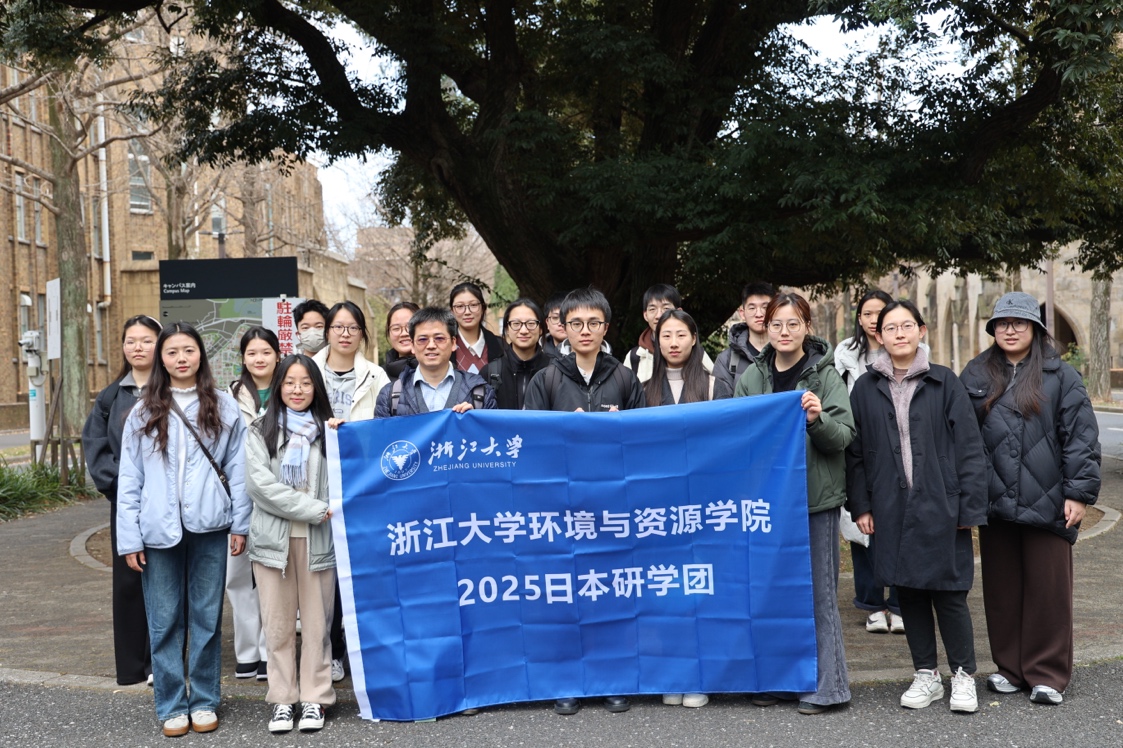
Pic. 1 Group photo of the study group and laboratory members
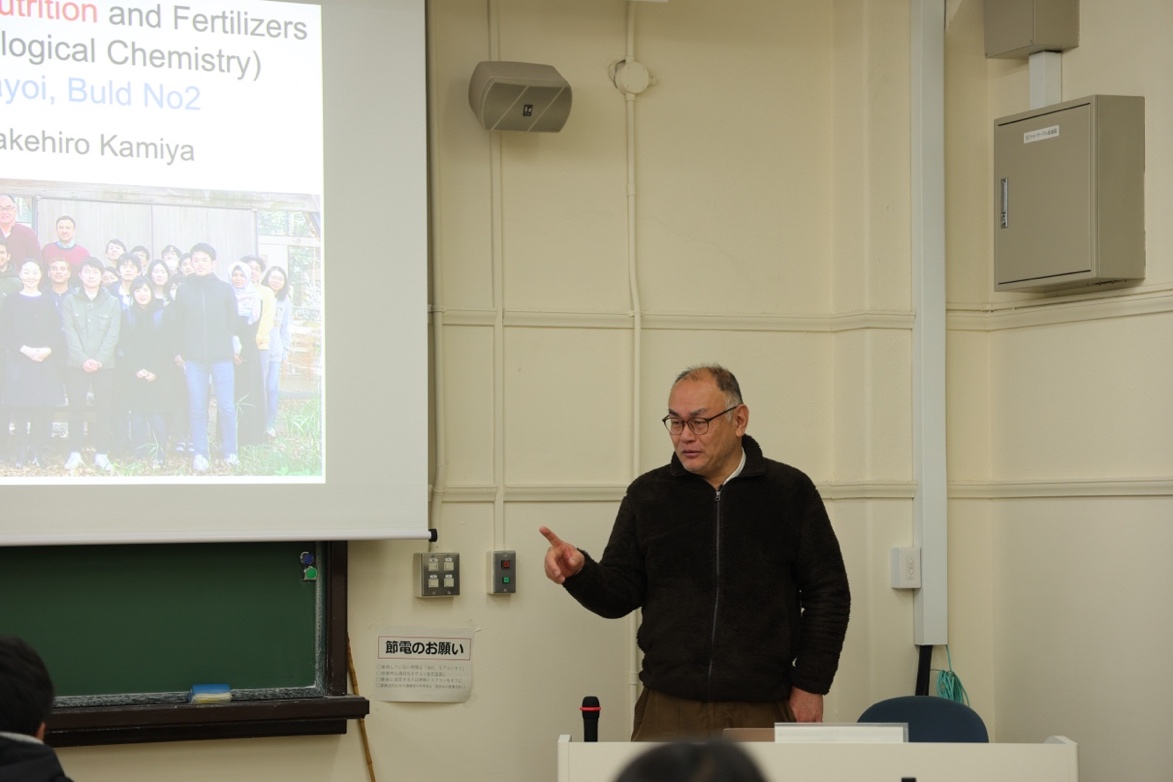
Pic. 2 Professor Toru Fujiwara
Associate Professor Li Yong first presented an overview of the College of Environmental and Resource Sciences, including its development history, academic structure, and key initiatives.

Pic. 3 Associate Professor Li Yong presented an overview of the College
Undergraduate students Zhou Yiqun and Tang Pingchuan from our college then shared their research findings. Tang Pingchuan presented his progress on the role of iron minerals in promoting free radical generation and soil pollutant degradation. Zhou Yiqun’s research utilized transcriptomics and metabolomics to investigate the toxic effects of the neonicotinoid pesticide clothianidin on earthworms, revealing physiological damage and changes at the genetic and metabolic levels. Future research will focus on cellular-level damage mechanisms, the combined effects of multiple pesticides, and the remediation potential of earthworms in contaminated soils.

Pic. 4 Zhou Yiqun
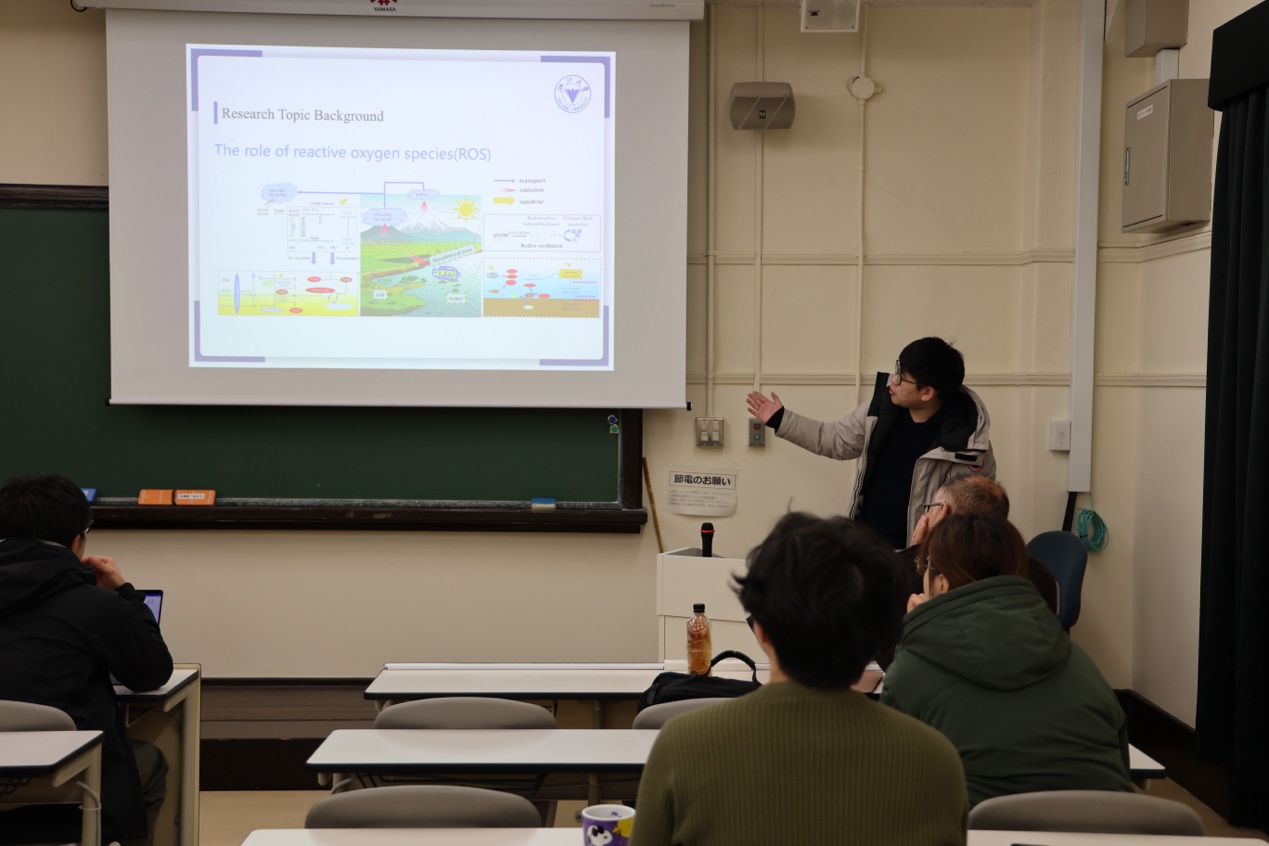
Pic. 5 Tang Pingchuan

Pic. 6 Discussion
Graduate students from Professor Fujiwara’s lab also presented their work. Notably, Wen Hao, a graduate student at the University of Tokyo, delivered a report on rice root growth in nutrient-heterogeneous environments using transparent soil systems. He introduced a cost-effective, innovative setup enabling 3D visualization and analysis of root system architecture (RSA) under ammonium (NH₄⁺) gradients. This research contributes significantly to our understanding of root adaptation mechanisms and sustainable agriculture practices.

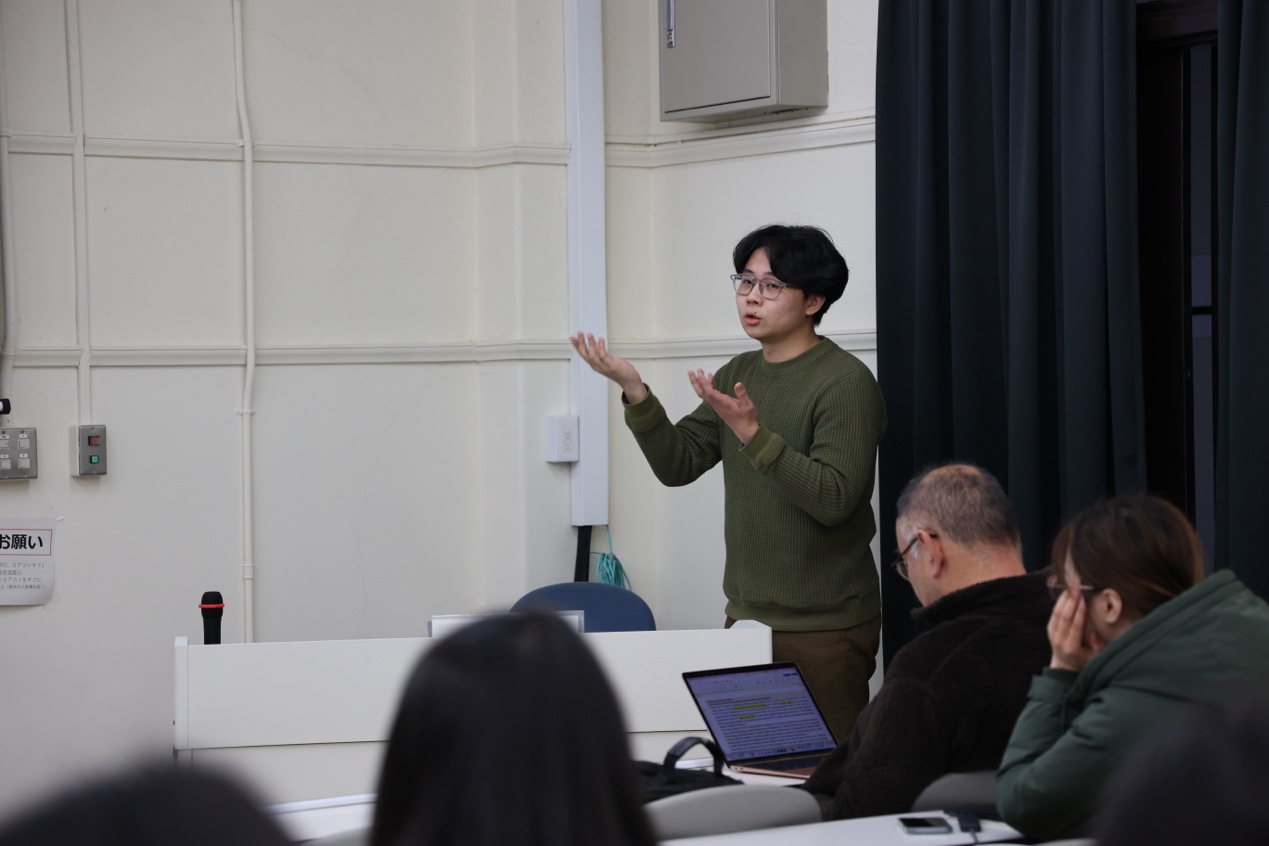
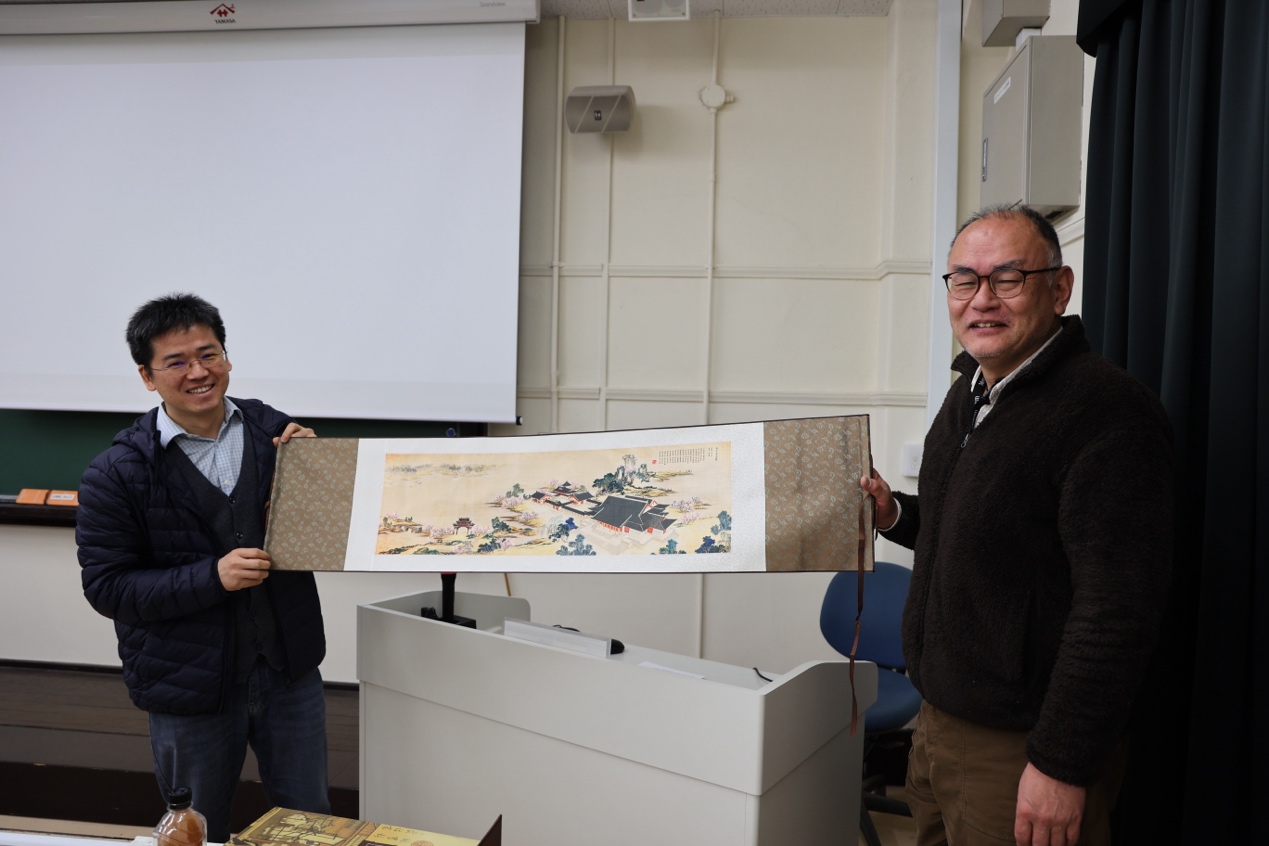
Pic. 7 Gift-giving group photo
The group was then guided by students of the University of Tokyo through the laboratory and greenhouse facilities, where they exchanged ideas regarding greenhouse equipment and parameter settings.
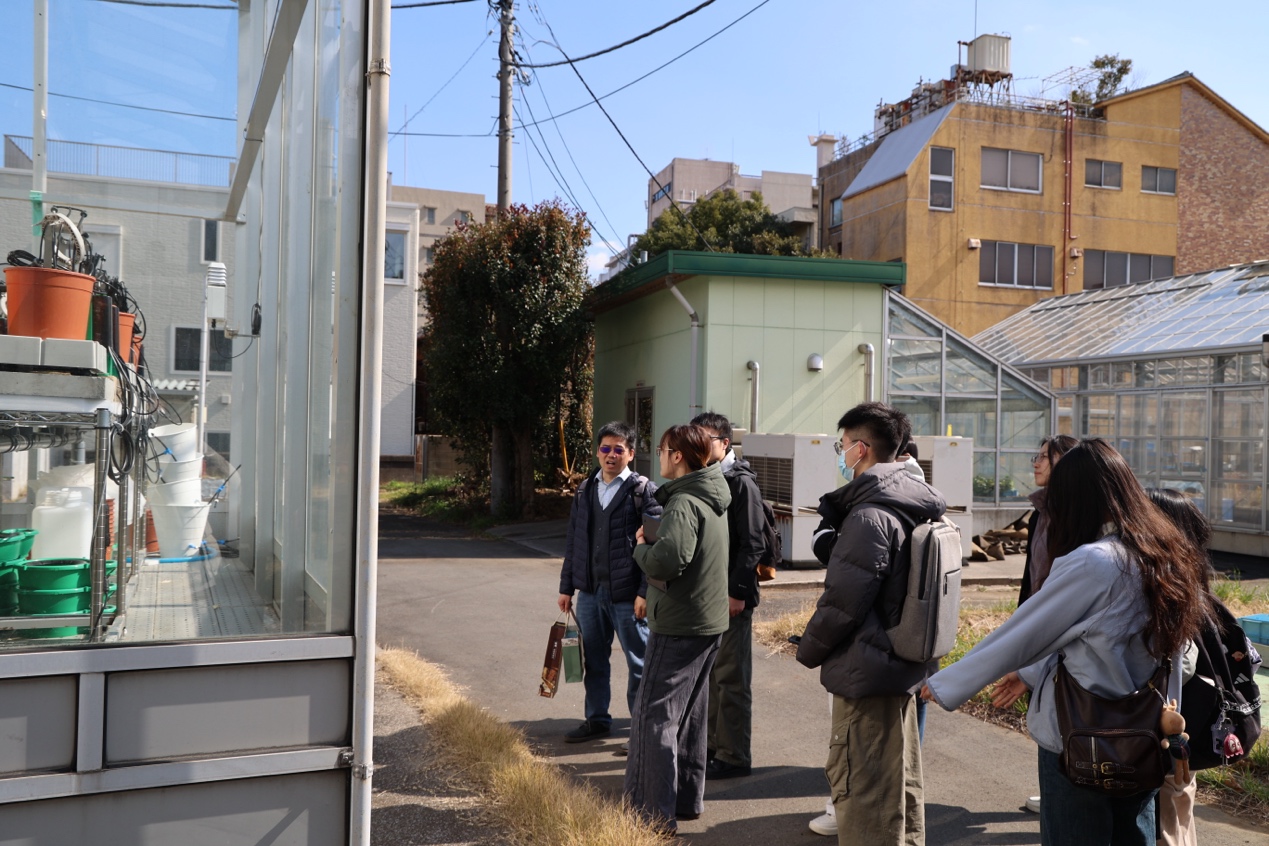
Pic. 8 Plant greenhouse tour
In the afternoon, the group met with Professor Keishi Senoo, head of the Soil Science Laboratory, and his team. ZJU alumnus Dr. Lü Han, currently an Assistant Professor at Tokyo University of Agriculture and Technology, also joined the exchange.
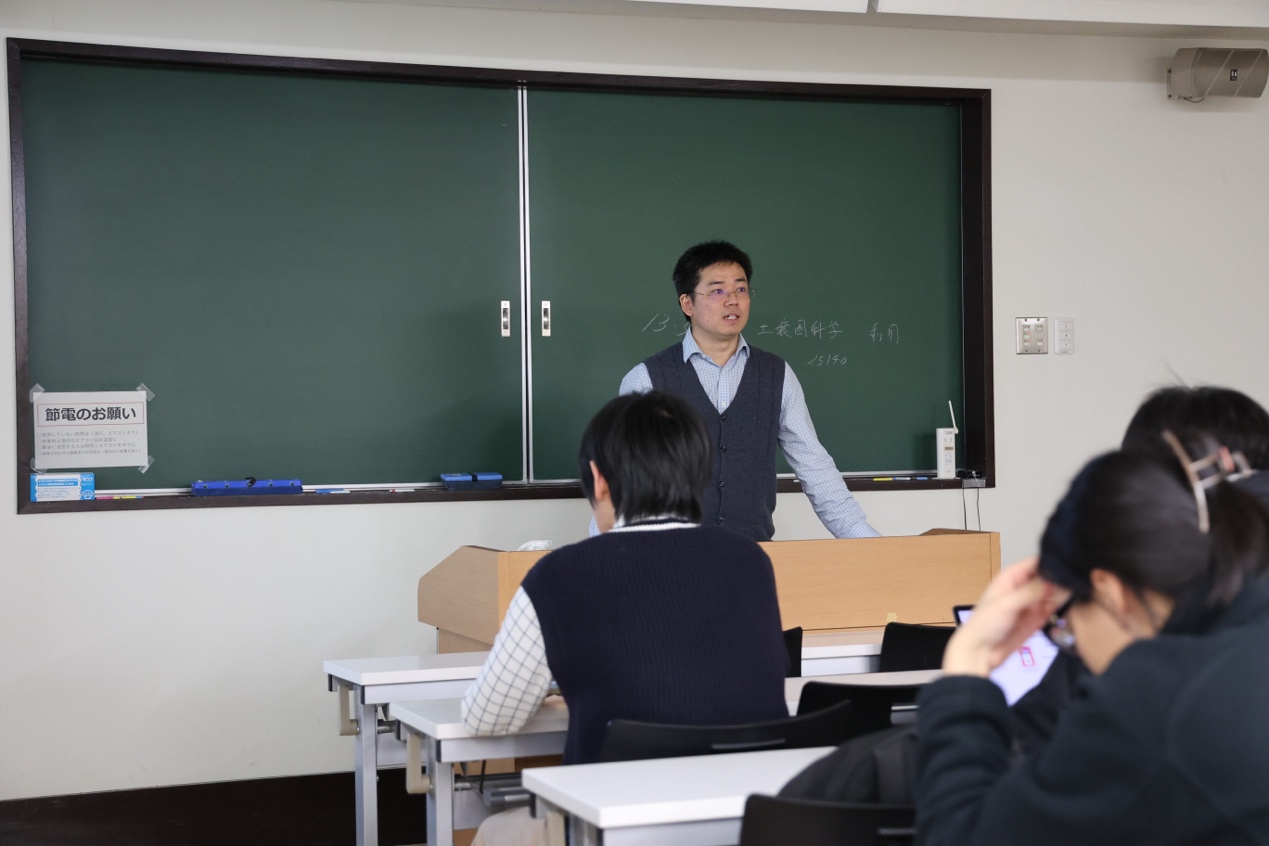
Pic. 9 Presentation by Associate Professor Li Yong
Associate Professor Li Yong delivered a presentation titled “Impact of Virus on Bacterial Communities and Nutrient Cycles in Paddy Soils”. Following this, three undergraduates—Xu Ruixi, Wang Yang, and Zhang Ruoxi—shared their respective research projects.
Xu Ruixi analyzed biodiversity conservation patterns in the Yangtze River Delta in the context of climate change.
Zhang Ruoxi presented methods to delineate safe thresholds for nitrate in Chinese groundwater and proposed a dynamic early-warning model based on long-term monitoring data.
Wang Yang discussed the toxicological effects of neonicotinoid pesticides on earthworms and their broader implications for soil function and agricultural sustainability. His findings highlighted the importance of developing environmentally friendly pesticide strategies to maintain soil ecosystem balance.

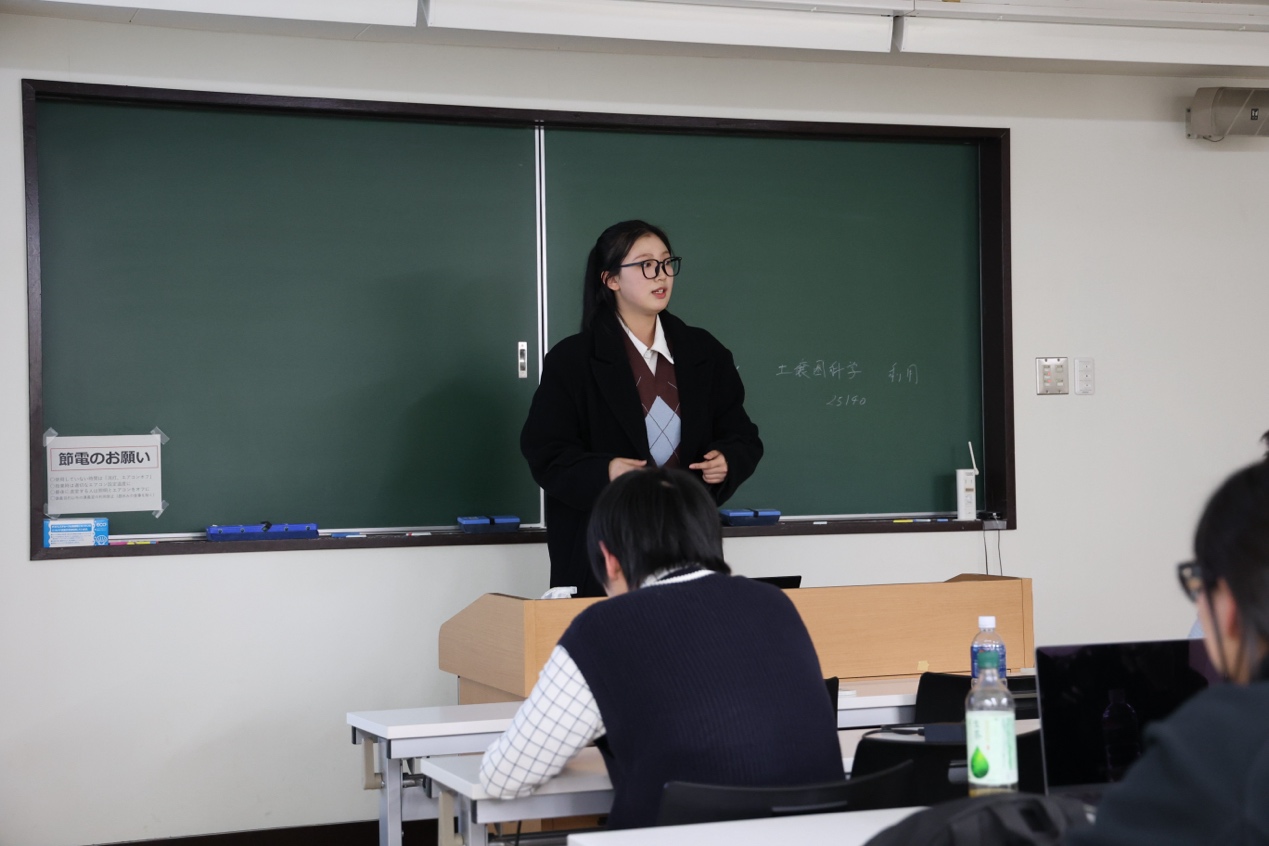
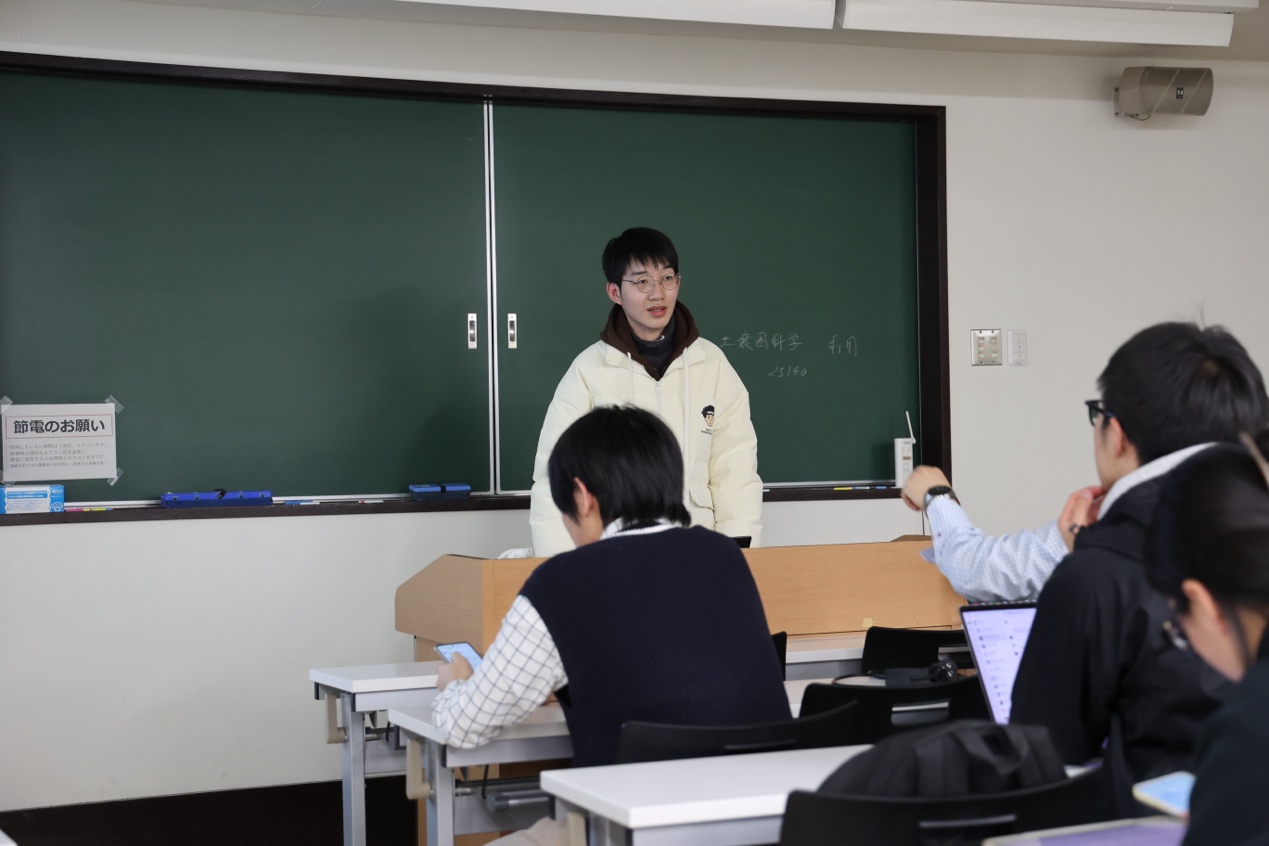
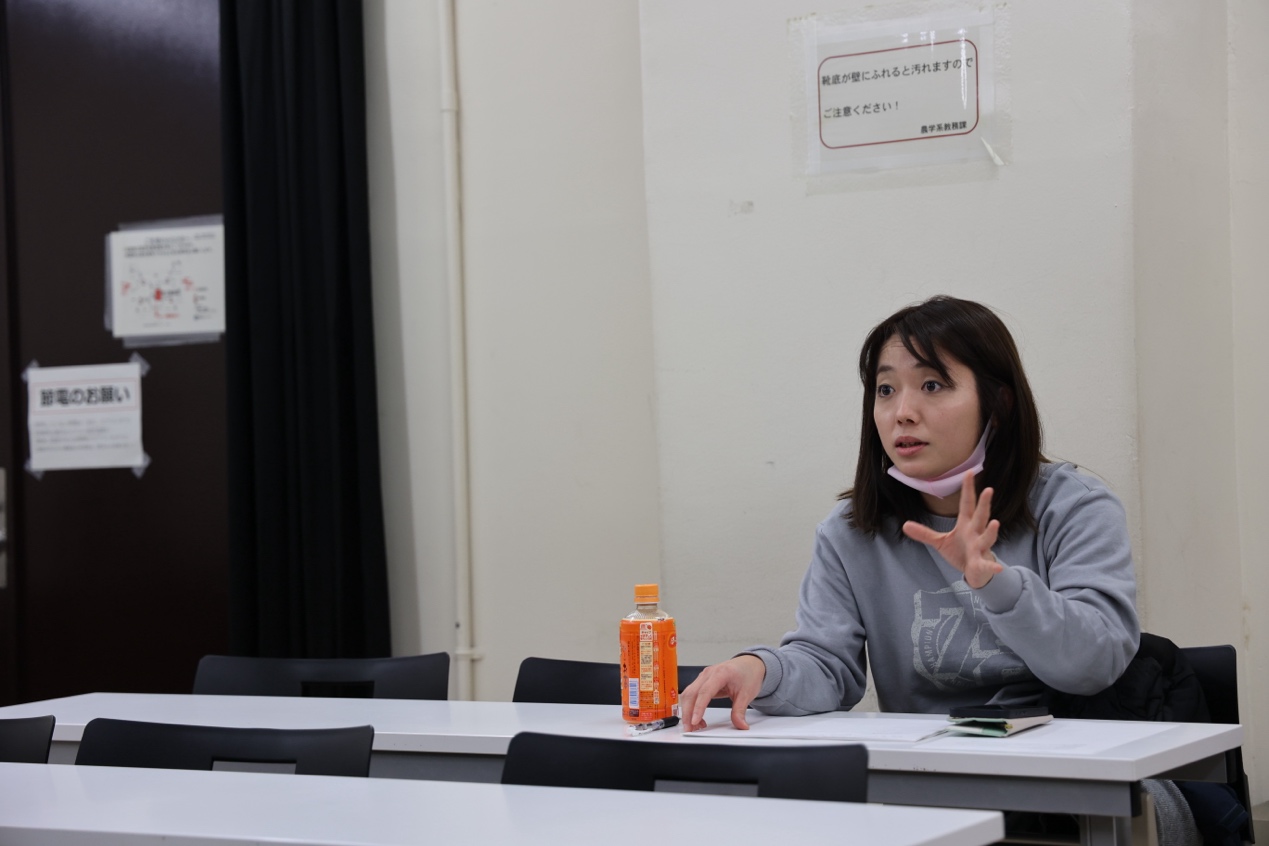

Pic. 10 Gift-giving group photo

Pic. 11 Group photo with Prof Keishi Senoo
On the morning of February 20, the group visited Osaka University’s Suita Campus. Mr. Yuichi Komizo, Director of the East Asia Center at the Center for Global Initiatives, welcomed the delegation. Assistant Professor Xixi Zhang provided a comprehensive overview of Osaka’s geographical and cultural features, the university’s development, academic programs, and campus environment, and detailed policies regarding international student admission.
Associate Professor Toyohiko Nakakubo from the Environmental Management Laboratory then introduced the research and teaching systems of the Sustainable Energy and Environmental Engineering program. The lab emphasizes the balance between industrial activity and natural ecosystems, conducting interdisciplinary studies on topics such as: Risk assessments of chemical releases during natural disasters, Environmental impact assessments (e.g., LCA) for rare metal recycling, Sustainable strategies aligned with electric vehicle expansion and supply chain risks.
Graduate students from the lab presented the following topics:
Hanrui Chen (ZJU alumnus): An integrated risk assessment of toxic metals in e-waste regions and corresponding soil remediation strategies.
Tsuji Koki: Planning and evaluation of biochar production using sludge from onsite wastewater treatment systems.
Renta Miyazaki: Risk management strategies for substances with both beneficial and hazardous properties, focusing on balancing societal needs and potential harms.
After the presentations, ZJU students actively engaged in discussions on research topics and study opportunities at Osaka University, with detailed responses provided by the hosts.
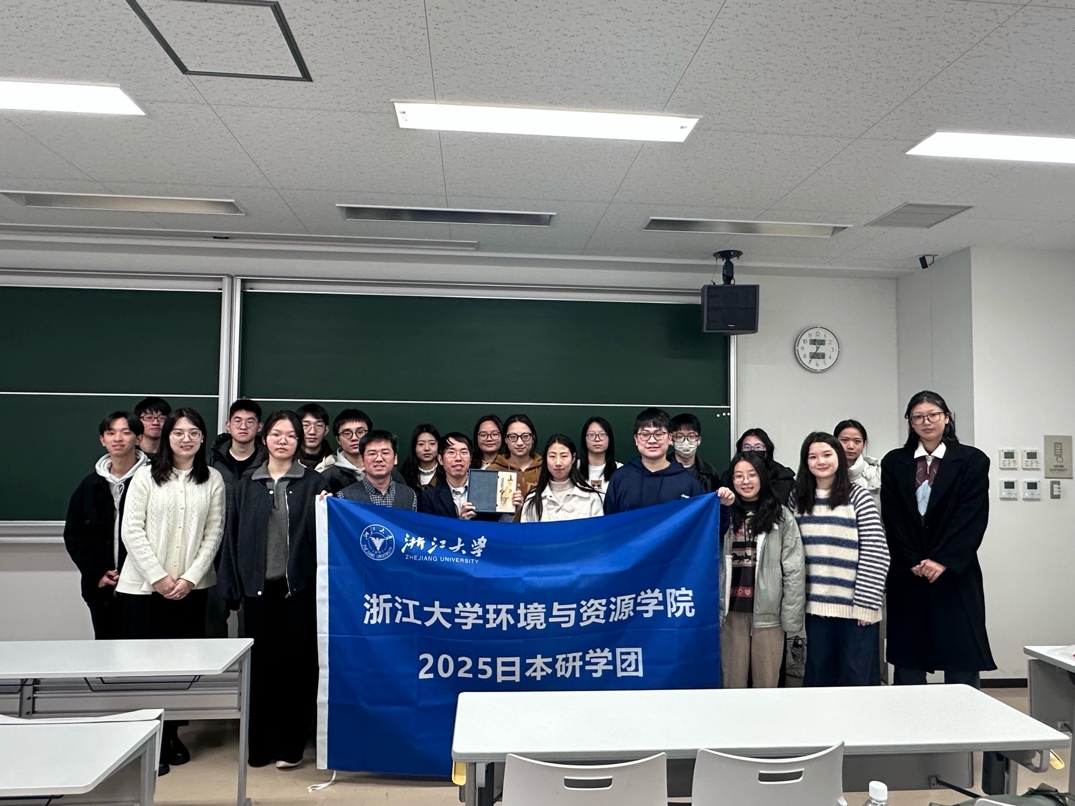
Pic. 12 Group photo at Osaka University
Alumni Visit
Alumnus Lü Han is currently an Assistant Professor at Tokyo University of Agriculture and Technology. His primary research areas include the molecular composition of organic matter, climate change, soil microorganisms, secondary soil minerals, and the soil carbon cycle. His research spans plant nutrition, soil science, environmental science, and agricultural science, with a particular focus on environmental dynamics and the carbon cycle. He has a rich academic background: from 2011 to 2015, he studied at the College of Resources and Environmental Sciences, Zhejiang University. He later pursued his master’s and doctoral degrees at the Graduate School of Agriculture and the Graduate School of Global Environmental Studies, Kyoto University. He has served as a postdoctoral researcher at the Japan Society for the Promotion of Science (JSPS), and conducted research at both the Graduate School of Agriculture and the Research Institute for Sustainable Humanosphere, Kyoto University.
Student Reflections
Tang Pingchuan: This exchange at Professor Toru Fujiwara’s laboratory at the University of Tokyo was incredibly rewarding for me. First, the research by Professor Fujiwara’s team on plant nutrient uptake and regulatory mechanisms left a deep impression on me. They are committed to uncovering how plants efficiently absorb and utilize trace elements in soil, such as boron and molybdenum, and are developing crop varieties that can still yield high outputs under low-fertilizer conditions. This kind of research has significant implications for the sustainable development of global agriculture.
Second, the team’s research on how plant roots respond to the spatial distribution of soil nutrients is also worth learning from. They discovered that plant roots can perceive the distribution of nutrients in the soil and change their growth direction to obtain more nutrients—this phenomenon is called “nutrient tropism. ”This discovery offers a new perspective for understanding the interactions between plants and their environment.
Through this exchange, I truly experienced the importance of interdisciplinary collaboration in advancing scientific research and technological innovation. Our research mainly focuses on soil chemical processes and pollutant degradation, while Professor Fujiwara’s team is focused on plant physiology and nutrient uptake mechanisms. Combining the two holds great potential for breakthroughs in improving soil environments and increasing both the yield and quality of crops.
Zhang Ruoxi: The exchange with the Plant Nutrition Research Team at the University of Tokyo brought me many insights. This team primarily studies how plants absorb nutrients from the soil—for example, they discovered a special protein that helps plants transport boron. They also explored how microbes in the soil affect plant growth.
Although they mainly study how plants “eat,” my research topic is more like guarding the safety boundary of China’s groundwater—protecting water sources by monitoring the extent of nitrate pollution. Surprisingly, we had quite a few sparks of connection. I presented a method for spatially delineating the “safety threshold” for nitrate in Chinese groundwater, and emphasized how to build a dynamic early-warning model using long-term monitoring data. Researchers in the lab raised questions about the migration paths and control methods of pollutants at the soil-groundwater interface, and I introduced our response measures database in return. They were very familiar with isotopic tracing techniques used in plant nutrition research, and described how nitrogen tracing could help refine pollution source analysis. This kind of cross-disciplinary perspective made me rethink the potential impact of farmland irrigation on groundwater pollution.
Xu Ruixi: I benefited greatly from this external exchange at the University of Tokyo. The interaction with the Soil Science Laboratory was especially important to me, as I presented my SRTP project and received questions and feedback from students and professors at UTokyo. Their professional questions made me reflect more deeply on the details of my project and pointed out many areas for improvement and further exploration, expanding my research horizons.
Throughout the exchange process, I not only gained knowledge, but also experienced an atmosphere of academic discussion. Students and professors at the University of Tokyo were very enthusiastic and inspiring.
Visiting the UTokyo campus also allowed me to feel the rich academic culture and campus spirit. Overall, this exchange activity has strengthened my determination to pursue deeper research, and increased my confidence in engaging with the international academic community. I look forward to more opportunities to participate in academic exchanges like this in the future.
Luo Yubo: This exchange at Osaka University not only gave me a more comprehensive understanding of the university, but also allowed me to gain valuable academic and cultural experiences. First, the academic exchange made me realize both my potential and my shortcomings in the field of environmental science.
Through conversations with students and faculty at Osaka University, I learned more about cutting-edge research in environmental management and sustainable energy, which further strengthened my resolve to pursue in-depth research in this field. In particular, during the visit to the Environmental Management Laboratory and the academic reports, I came to a deep understanding that, as global environmental problems become increasingly serious, environmental protection work is not only about pollution control, but must also involve prevention at the source and the establishment of a sustainable environmental management mechanism across the entire society. Topics discussed in the reports—such as e-waste, wastewater treatment, and chemical risk assessments—made me realize that the complexity and challenges of environmental science research far exceed what we usually perceive, covering a wide and profound range of fields.
In addition, I was also deeply inspired by the academic atmosphere and spirit of innovation at Osaka University. As a globally renowned research university, Osaka University emphasizes interdisciplinary collaboration and the cultivation of global perspectives, especially in its research on sustainable development and environmental protection. Its research not only focuses on current environmental issues, but also looks ahead to long-term social change and ecological sustainability. This made me deeply feel the responsibilities I bear as a student in environmental science.
Through this exchange, I have become more aware that the core of scientific research is not only the pursuit of knowledge accumulation, but also making contributions to the betterment of society and the environment. Therefore, in my future academic research, I hope to not only focus on the depth of theory, but also on its practical application—striving to closely link scientific research with social needs, and contribute to solving global environmental problems.
This exchange has not only deepened my understanding of the discipline of environmental science, but also inspired my motivation to study more proactively. In my future learning and research, I will continue to uphold the spirit of seeking truth and being pragmatic, as well as being bold in innovation, and strive to play my part in the cause of environmental protection.
